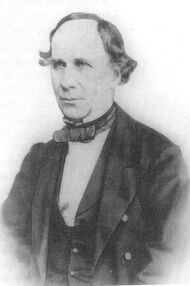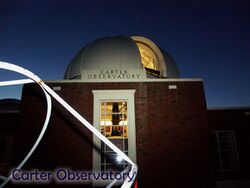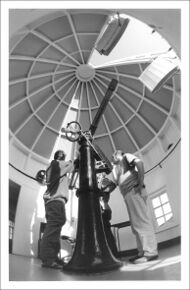Biography:Thomas Cooke (scientific instrument maker)
- This page is about the scientific instrument maker. For other persons named Thomas Cooke, see Thomas Cooke (disambiguation)
Thomas Cooke (8 March 1807 – 19 October 1868) was a British scientific instrument maker based in York. He founded T. Cooke & Sons, the scientific instrument company.[1][2]
Life
Thomas Cooke was born in Allerthorpe, near Pocklington, East Riding of Yorkshire, the son of James Cook (a shoemaker).[1][3][4][5]
His formal education consisted of two years at an elementary school (possibly the school of John Whitaker, also of Allerthorpe),[3] but he continued learning after this and he taught himself navigation and astronomy with the intention of becoming a sailor. His mother dissuaded him from that career and he became a teacher. He made such a success of being an impromptu teacher to the farmers’ sons of the Pocklington district, that only a year later he was able to open a village school at Bielby. He continued to teach others by day and learn himself by night, and soon moved his school from Bielby to Skirpenbeck.
At Skirpenbeck he met his future wife, who was one of his pupils, and five years his junior. Fifty years on she spoke of how her husband developed his brief rudimentary education into becoming a schoolmaster: “He first learned mathematics by buying an old volume from a bookstall with a spare shilling. He also got odd sheets, and read books about geometry and mathematics, before he could buy them; for he had very little to spare”.
But Cooke's interest in mathematics and science was practical as well academic. He had also retained his interest in navigation and instruments, and while at Skirpenbeck he made his own first rudimentary telescope – grinding a lens by hand out of the bottom of a glass whisky tumbler, then mounting in into a frame that he soldered together from a piece of tin. In 1829 he moved to York and worked as a mathematics schoolmaster at the Rev. Schackley's School in Ogleforth,[6] near York Minster. He also taught in various ladies' schools to increase his income.
His marriage to Hannah was to produce seven children, five of whom were boys. Two of these Charles Frederick (1836–98) and Thomas (1839–1919) subsequently joined him in the business he founded in 1836 at number 50 (now renumbered to 18) Stonegate, close to York Minster with the assistance of a loan of £100 from his wife's uncle.
Cooke studied optics and became interested in making telescopes, the first of which was a refracting telescope with the base of a tumbler shaped to form its lens. This led to his friends including John Phillips encouraging him to make telescopes and other optical devices commercially.[7][8][9]
Work
In 1837 he established his first optical business in a small shop at 50 Stonegate, York, and later moved to larger premises in Coney Street. He built his first telescope for William Gray. At that time, the excise tax on glass discouraged the making of refracting telescopes, which were usually imported from abroad. Cooke was thus one of the pioneers of making such telescopes in Britain.
He made more instruments and built his reputation. He was not only an optician but had mechanical abilities as well, and among other things, manufactured turret clocks for church towers. He founded the firm T. Cooke & Sons. In 1855 he moved to bigger premises, the Buckingham Works at Bishophill in York, where factory methods of production were first applied to optical instruments.[10] He exhibited at the York Exhibition in 1866 demonstrating his three-wheeled, steam-powered car which he claimed could carry 15 people at 15 mph for a distance of 40 miles.[11]
One of his finest achievements was the construction of the 25-inch 'Newall' refractor for Robert Stirling Newall; sadly, Thomas died before seeing it completed. For some years the Newall was the largest refracting telescope in the world.[12] On Newall's death it was donated to the Cambridge Observatory and finally moved in 1959 to Mount Penteli observatory in Penteli, Greece. He made a telescope for the Royal Observatory, also Greenwich and another for Prince Albert. The firm amalgamated with Troughton & Simms (London) to become Cooke, Troughton & Simms in 1922 and this later became part of Vickers, but still run by his sons Thomas & Frederick.
Thomas Cooke was succeeded by his sons, Thomas and Frederick. He is buried in York Cemetery.
Telescopes in use today
- A telescope made by Thomas Cooke is still in daily use at Carter Observatory – The National Observatory of New Zealand, delivering excellent results. The original 9-inch triplet lens has been replaced by a 9 1/2 doublet made by renowned optician Garry Nankivell.
- At the observatory in the Museum Gardens, York there is a working 4-inch telescope, built for the Yorkshire Philosophical Society in 1850. A second unit of the same construction was purchased and installed in the observatory at Bootham School, York in 1854. A third matching instrument, dating from the same period, was donated to Friendsʼ School, Hobart in 1974 by the grandson of Jonathan Backhouse Hodgkin. All three instruments remain in active service.
- A 5" refractor dating from 1883 is still in use at Coats Observatory, Paisley, Scotland.
- A 5" refractor dating from 1880 is still in regular use at Clanfield Observatory, Hampshire.[13]
- There is a 6" Cooke telescope in the Airdrie Public Observatory, Airdrie, North Lanarkshire, Scotland run by the Airdrie Astronomical Association.[14]
- A 6” Cooke refractor is the main telescope in use at the Hampstead Observatory in London. Known as the ’Wildey telescope’ (in tribute to renowned master optician, Henry Wildey), the telescope can be used by the public on the observatory's open nights (most Friday and Saturdays).[15]
- There is a 6" Cooke telescope in use at the Baxendell Observatory in Hesketh Park, Southport [16]
- A 6" Cooke refractor exists in the 1929 observatory of the University of Saskatchewan, Saskatoon, Saskatchewan, Canada,[17]
- A 6.25" refractor known as the 'Lockyer Telescope' is in use at the Norman Lockyer Observatory in Sidmouth, Devon, UK. The lens, made by Cooke, was first used in 1865 in a telescope built by Norman Lockyer. Cooke later rebuilt the telescope in its present form in 1871. The telescope was positioned in several locations before being moved to Sidmouth in 1912, where it remains. Lockyer used this telescope to discover helium in the solar corona. It was restored in 1995 and is now used mainly for public-outreach.[18]
- A 6.5" refractor manufactured in 1870 is in use at the Assheton Observatory at Rossall School.
- A 6.5" refractor manufactured in 1876 is in use at the Astronomic Observatory[19] of the Odessa National University in Odessa, Ukraine.
- An 8" refractor dating from 1864, known as the Thorrowgood Telescope belongs to the Royal Astronomical Society and is operated at the Cambridge Observatory.
- An 8" refractor is housed in the Jeremiah Horrocks Observatory, Moor Park, Preston, Lancashire.
- The Fry telescope,[20] an 8" refractor manufactured in 1862, is in regular use at the University of London Observatory[21] in Mill Hill, London.
- A 10" refractor from 1860 is in use at the Blackett Observatory, Wiltshire.[22]
- A 10" refractor from 1871, which was purchased by St. Andrews in 1938 and used as a training telescope, has been in use since 1951 at Mills Observatory, Dundee, Scotland.
- A 18" refractor was acquired by National Observatory (Brazil) in 1911 but only setup on 1922 due to World War I. It is the largest refractor in Brazil and it is used for outreach nowadays.
- A 25" refractor from 1869 "Newall Telescope" is in use at the National Observatory of Athens, Penteli, Greece[12]
See also
References
- ↑ 1.0 1.1 Pritchard, Charles (1868). "Thomas Cooke". Monthly Notices of the Royal Astronomical Society (London: Royal Astronomical Society) 29: 130–135. http://articles.adsabs.harvard.edu/full/seri/MNRAS/0029//0000130.000.html. Retrieved 15 November 2015.
- ↑ Argyle, Robert W. (2007). "Thomas Cooke (1807–1868)–A Great English Telescope Maker". The Observatory 127: 392–400. Bibcode: 2007Obs...127..392A. http://articles.adsabs.harvard.edu/full/2007Obs...127..392A. Retrieved 17 November 2015.
- ↑ 3.0 3.1 "Allerthorpe Directory of Trades and Professions for 1823". GENUKI. 29 May 2011. Archived from the original on 13 October 2012. https://web.archive.org/web/20121013203639/http://www.genuki.org.uk/big/eng/YKS/ERY/Allerthorpe/Allerthorpe23.html. Retrieved 10 December 2012.
- ↑ Martin Lunn. "Thomas Cooke: Telescope Maker of York.” Pp.115–128 in Whitworth (2000). Whitworth, Alan. 2000. Aspects of York: Discovering Local History. Barnsley, Wharncliffe Books.
- ↑ Clerke, A. M.; Brech, Alison J. (2004). Oxford Dictionary of National Biography. Oxford, England: Oxford University Press. doi:10.1093/ref:odnb/6183. http://www.oxforddnb.com/view/article/6183. Retrieved 7 November 2015.
- ↑ A Brief account of Durham Cathedral: with notices of the castle, university ... – Google Boeken. Books.google.com. https://books.google.com/books?ei=nZWESYilIYzKM6WPvaAK&num=100&id=TzwQAAAAYAAJ&dq=shackley+ogleforth+school&q=ogleforth++&pgis=1#search_anchor. Retrieved 10 December 2012.
- ↑ Feinstein, C. H., ed (1981). York 1831–1981:150 Years of Scientific Endeavour and Social Change. The Ebor Press. p. 38. ISBN 0-900657-56-1.
- ↑ Willis, Ronald (1988) [1972]. The illustrated portrait of York (4th ed.). Robert Hale Limited. p. 184. ISBN 0-7090-3468-7.
- ↑ McConnell, Anita (1992) [1992]. Instrument makers to the world, A history of Cooke, Troughton and Simms (1st ed.). University of York. p. 50. ISBN 1-85072-096-7.
- ↑ Feinsten, C. H., ed (1981). York 1831–1981:150 Years of Scientific Endeavour and Social Change. The Ebor Press. p. 39. ISBN 0-900657-56-1.
- ↑ Gilbank, P.. "Thomas Cooke". http://www.pocklingtonhistory.com/archives/people/famous/thomascooke/. Retrieved 16 March 2014.
- ↑ 12.0 12.1 The Hellenic Archives of Scientific Instruments. "Newall Refractor". http://www.hasi.gr/instruments/ast73. Retrieved 16 March 2014.
- ↑ Charman, Matt. "5-inch and 4.5-inch Telescopes – Hampshire Astronomical Group (HAG) – Clanfield Observatory". Hampshire Astronomical Group, Clanfield Observatory, Hampshire, UK: Hantsastro.org.uk. http://www.hantsastro.org.uk/tour/5inch.php. Retrieved 10 December 2012.
- ↑ "AAA Home Page". Airdrieobservatory.com. http://www.airdrieobservatory.com. Retrieved 10 December 2012.
- ↑ "HSS Hampstead Observatory". hampsteadscience.ac.uk. http://www.hampsteadscience.ac.uk/astro/observatory.html. Retrieved 9 January 2017.
- ↑ "Home Page". fernleyobservatory.org. http://www.fernleyobservatory.org. Retrieved 26 August 2016.
- ↑ "University of Saskatchewan Observatory". artsandscience.usask.ca. http://artsandscience.usask.ca/physics/observatory/. Retrieved 17 May 2017.
- ↑ "The Lockyer 6¼-inch refractor (circa 1871)". https://projects.exeter.ac.uk/nlo/tour/lockyertelescope.htm. Retrieved 9 September 2017.
- ↑ "AO | Одесская астрономическая обсерватория". Astro-observ.odessa.ua. http://www.astro-observ.odessa.ua/. Retrieved 10 December 2012.
- ↑ "Fry Telescope". Ulo.ucl.ac.uk. 17 April 2012. http://www.ulo.ucl.ac.uk/telescopes/fry/. Retrieved 10 December 2012.
- ↑ "ULO Home Page". Ulo.ucl.ac.uk. 17 April 2012. http://www.ulo.ucl.ac.uk. Retrieved 10 December 2012.
- ↑ "About". Blackett Observatory. 11 October 2002. http://www.blackettobservatory.org/about.html. Retrieved 10 December 2012.
External links
- MNRAS 29 (1869) 130–135
- Carter – National Observatory of New Zealand
- A microscope made by Thomas Cooke
- Working Thomas Cooke 6.5" refractor telescope in Odessa Ukraine





